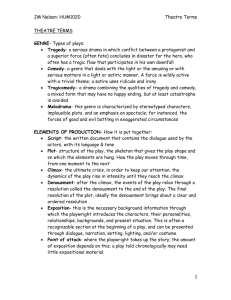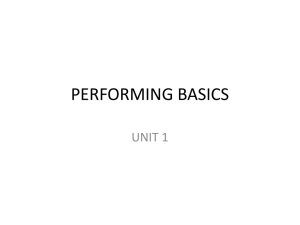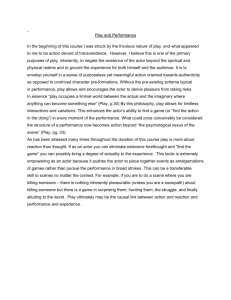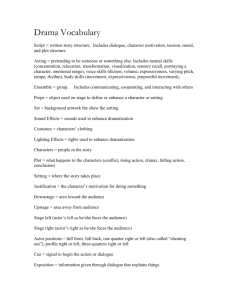Genre- type of play
advertisement
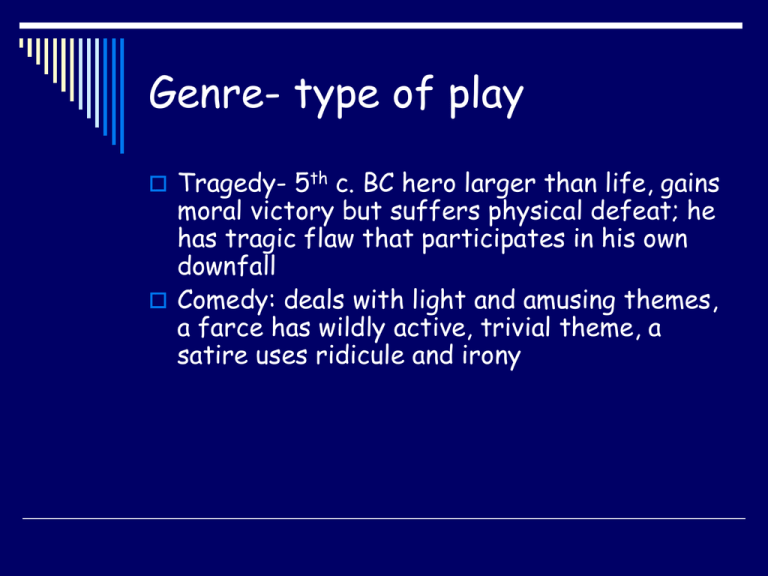
Genre- type of play Tragedy- 5th c. BC hero larger than life, gains moral victory but suffers physical defeat; he has tragic flaw that participates in his own downfall Comedy: deals with light and amusing themes, a farce has wildly active, trivial theme, a satire uses ridicule and irony Genre- type of play Tragicomedy- mixed form with no happy ending, but at least catastrophe is avoided Melodrama- characterized by stereotyped characters, implausible plots, and an emphasis on spectacle- the forces of good and evil battling in exaggerated circumstances The Play Plot- structure of the play, the framework on which all the other elements hang, how the play moves through time from one event to the next Point of attack- where the playwright takes up the story, if set in chronological order, little exposition is needed How It’s Put Together Exposition- necessary background information through which the playwright introduces the characters; can be delivered in the form of dialogue, narration, setting, lighting, or costume; often at the beginning How It’s Put Together Complication- frustrates the expected course of events, keeps audience interested Inciting incident- in the complication, an action or decision that upsets the current state of affairs How It’s Put Together Foreshadowing- prepares the audience for subsequent action, gives credibility for future action, and moves the play forward by pointing to events that will occur later Discovery- revelation of information about characters, relationships, and feelings Reversal Reversal –a sudden turn of fortune Reversal In comedy it often changes the roles of the social classes How It Ends Climax- the ultimate crisis, the dynamics of the play rise in intensity until this moment Denouement- the final resolution, material following the crisis, the intensity lessons to the end of the action The Actors Script- dialogue of actors, language & tone Character- the psychological motivation of the persons in play; shows how persons with specific character motivations react to the circumstances in which they find themselves Protagonist- central personage, which is not always clear, it depends upon whom the director chooses to focus. We journey through the workings of the play by the actions and decisions of the protagonist. Actor’s portrayal of the role The Actor: the main channel of communication between the playwright and the audience. The actor’s portrayal of a role that enhance our response and understanding are two-fold: (1) speech, words written by playwright, manner in which the lines are delivered (2) physical reinforcement of the character’s motivation The consistency of the motivations drives the decisions and actions of the actor Theme Theme-the ideas that comprise the intellectual content of the play; not necessarily the plot, which is what the play is about, but the thought behind the play which is for us to discover and develop There are three aspects of this a) The playwright’s idea, b) The interpretation of the director & his decisions c) The audience’s perception Visual Elements: Types of Theatres The theatre provides aesthetic distance, our response is shaped by the design of the space in which the play is produced Arena : audience on all sides Thrust: audience on three sides Proscenium : audience views play through a frame Visual ElementsScene Design Scene design (stage setting)- creates an environment conducive to the production’s ends Tools of composition are used- line, form, mass, color, repetition, and unity- but scene design sculpts in 3-D space Scene designer limited by the stage space, concepts of the director, & the abilities of the staff available to execute the design Visual ElementsLighting Design Lighting design- reinforces the dramatic structure and dynamics of the play by working with light and shade; without shadows and highlights the human face and body become imperceptible The lighting designer works to sculpt with light and shadows; they must enhance the color of a costume, accent the physique of an actor and reinforce the plasticity of a setting Visual ElementsCostume Design Stage Costuming- costume designers work with the entire body of the actor including hair styles and makeup to suit a specific purpose -stage costuming has three functions: accents which actors are the most important & their relationships reflects particular era, time of day, climate, season, or location reveals the style of the performance, the characters of the personages, the personages’ social position, profession, cleanliness, age, physique, and health PropertiesSet Props Set props- these are part of the scene design, such as furniture, pictures, rugs, fireplace accessories, etc. They identify the mood of the play and the character of those who inhabit the set Properties can be significant to our understanding of a play- if all is neat and in order as the curtain opens, but as the play develops the actors disrupt the properties, that transition can help illustrate what may have happened PropertiesHand props Hand props- used by the actors to help portray characters, such as cigarettes, papers, glasses Whatever an actor carries on and off stage If the actor carries it, it’s a prop, if the actor wears it, it’s a costume Aural Elements Background music Actor’s voices Sound effects Dynamics Structural pattern of a play The director establishes audience interest This must peak and then relax to keep audience engaged Director controls the actors’ volume & intensity, both bodily and vocal

